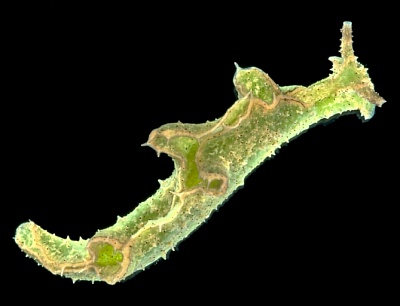
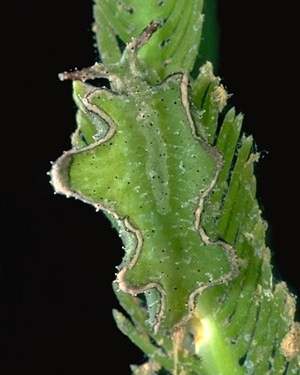
Elysia tomentosa
Jensen, 1997
Order: SACOGLOSSA
Superfamily: ELYSIOIDEA
Family: Elysiidae
DISTRIBUTION
Probably Indo-West Pacific.
PHOTO
Koumac Beach (=Baie de Ouanap), near Koumac, New Caledonia, 20°34'S, 164°16'E, Mixed soft and hard substrate, grassbeds, algae, 23 October 1993,
Upper Photo: 2 animals, 14, 20mm long alive, AM C200589. Lower Photo: 50mm long alive, on Caulerpa taxifolia. This specimen shows the elongate renal ridge behind the pericardium. AM C200588. Photos: Bill Rudman
This species was described from the Abrolhos Ids in northwestern Australia. In colour it was described as olive green, 'more or less covered in tiny white dots which may form larger white dots especially on the head and the distal part of the inner parapodial surface.' The edge of the parapodia were described as having an orange or light red margin and the rhinophores were either olive green or reddish brown. Orange brown dots are scattered dorsally as are small black spots many of which are ocellate. The papillae are white or transparent if along the parapodial margin. The body is extremely papillose and many of the papillae, especially on the parapodial margins, are branched. There is a long renal ridge extending a considerable distance behind the pericardium, and there is an anterior transverse groove across the foot. Grows up to 50mm long alive.
Jensen compares E. tomentosa with E. expansa (O'Donoghue, 1924), which was also described from the Abrolhos Islands, but in that species there are fewer papillae, they are never branched, and there is a black line at the parapodial edge [see Jensen 1993]. It is possible that E. pilosa Risbecia 1927, from New Caledonia, is the same species, but Risbec's description of the external features of his species are not clear enough to make an adequate comparison.
Specimens illustrated here fit Jensen's description well but they usually differ in having a black line on the inside and outside of the parapodia, along the inside edge of the pink parapodial margin. The presence and absence of this line seems to be variable in this species. Jensen does not mention its food, but records from New Caledonia and Sydney suggest it feeds on Caulerpa taxifolia.
See close-up photos of papillae and colour pattern. See also Elysia cf. tomentosa Page. The animals on that page may be this species, but appear much more papillate than illustrated by Jensen (1997) [see message from Kathe Jensen with photo of type material].
References:
• Jensen, K.R. (1993) Sacoglossa (Mollusca, Opisthobranchia) from Rottnest Island and central Western Australia. [In]: Proceedings of the 5th International marine Biological Workshop: The marine Flora and Fauna of Rottnest Island, Western Australia. (Eds: Wells, F.E.; Walker, D.I.; Kirkman, H., Lethbridge, R.) Western Australian Museum, Perth, 207-253.
• Jensen, K.R. (1997) Sacoglossa (Mollusca,Opisthobranchia) from the Houtman Abrolhos Islands and central Western Australia. [In:] The Marine Flora and Fauna of the Houtman Abrolhos Islands, Western Australia. (Ed: Wells, F.E.) Western Australian Museum, Perth, 307-333.
• O'Donoghue, C. H. (1924) Report on Opisthobranchiata from the Abrolhos Islands, Western Australia, with description of a new
parasitic copepod. Journal of the Linnean Society of London, 35: 521-579, pls. 27-30.
• Risbec, J. (1928). Contribution à l'étude des nudibranches Néo-Calédoniens. Faune des Colonies Françaises, 2: 1-328.
• Risbec, J. (1953) Mollusques nudibranches de la Nouvelle-Caledonie. Faune de l'Union Francaise, Paris: Libraire Larouse, 15: 1-189.
Rudman, W.B., 2003 (July 23) Elysia tomentosa Jensen, 1997. [In] Sea Slug Forum. Australian Museum, Sydney. Available from http://www.seaslugforum.net/find/elystome
Related messages
Elysia expansa? from India
November 6, 2009
From: Vishal Bhave
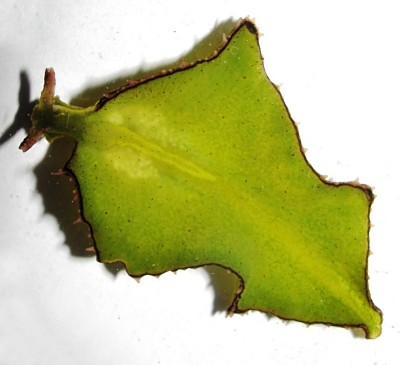
Concerning message #787:
I got 2 specimens of this Elysia on Caulerpa scalpelliformis.
As per comment from Kathe Rose Jensen,
" I think this is more likely Elysia expansa, which also occurs on Caulerpa, sometimes together with E. tomentosa. E. expansa has that dark brown, almost black stripe along parapodial margins and some glandular patches at the tips of the parapodial lobes. In E. tomentosa parapodial margins are pale red and usually more papillose than E. expansa."
Locality: Ambolgad, Rajapur, Ratnagiri, 20 centimeters, Maharashtra, India, Arabian sea, 30 October 2009, Intertidal, in rockpool. Length: 40 mm
Vishal Bhave
vishalbhave@gmail.com
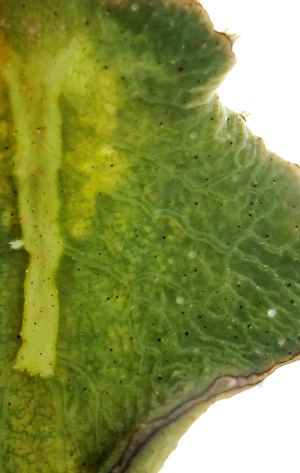
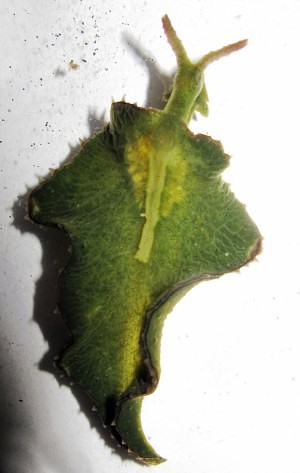
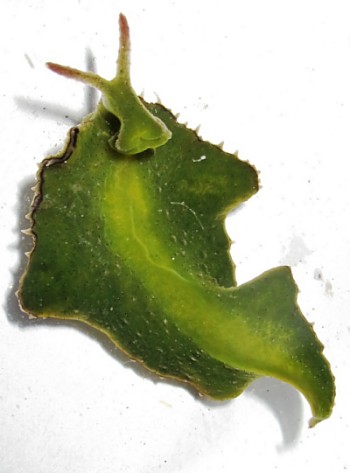
Dear Vishal,
This is the same as the animals in your earlier message [#22438] which I identified as Elysia tomentosa. I thought from Kathe's earlier comments [#10658], that she had reached the same conclusion. The most distinctive feature of this species, apart from the large expansive parapodia, and papillae, is the broad pinkish band along the parapodial edge, which is edged on both the inside and outside by a black line. This is fairly constant in all the animals on the Forum I have identified as E. tomentosa. O'Donoghue's description (1924) of E. expansa was of a preserved specimen, but the collector noted a black border to the parapodia. Jensen (1993) identified an Elysia with a 'dark brown' border to the parapodia as E. expansa. On the other hand, Jensen (1997) described E. tomentosa to have 'orange or light-red' parapodial margins. Other external features seem to be similar in both 'species'. So what do we do with animals with your colour pattern, which is characterised as I said earlier by a pinkish border, outlined in black.
I guess its anatomy needs to be compared with that of E. tomentosa and E. expansa - but re-identifying E. expansa may be problematic. In the meantime I think I will persist in calling this E. tomentosa. The alternative would be to give it a number, because it certainly doesn't exactly fit the decriptions of any named species.
-
Jensen, K.R. (1993) Sacoglossa (Mollusca, Opisthobranchia) from Rottnest Island and central Western Australia. [In]: Proceedings of the 5th International marine Biological Workshop: The marine Flora and Fauna of Rottnest Island, Western Australia. (Eds: Wells, F.E.; Walker, D.I.; Kirkman, H., Lethbridge, R.) Western Australian Museum, Perth, 207-253.
-
Jensen, K.R. (1997) Sacoglossa (Mollusca,Opisthobranchia) from the Houtman Abrolhos Islands and central Western Australia. [In:] The Marine Flora and Fauna of the Houtman Abrolhos Islands, Western Australia. (Ed: Wells, F.E.) Western Australian Museum, Perth, 307-333.
-
O'Donoghue, C. H. (1924) Report on Opisthobranchiata from the Abrolhos Islands, Western Australia, with description of a new
parasitic copepod. Journal of the Linnean Society of London, 35: 521-579, pls. 27-30.
Best wishes,
Bill
Re: Elysia tomentosa from Ratnagiri, India
May 15, 2009
From: Vishal bhave
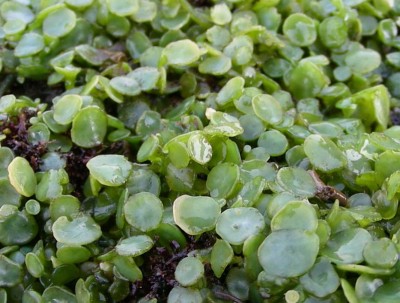
Concerning message #22457:
I have observed Elysia tomentosa on other species of Caulerpa which may be C. peltata or C. racemosa (I am bit confused between those two).
First image is of Caulerpa peltata? on which I have seen Elysia tomentosa and other one is of Caulerpa scalpelliformis.
Locality: Rocky patch, Mandvi, Ratnagiri. Photographer: Vishal Bhave.
Vishal Bhave
vishalbhave@gmail.com
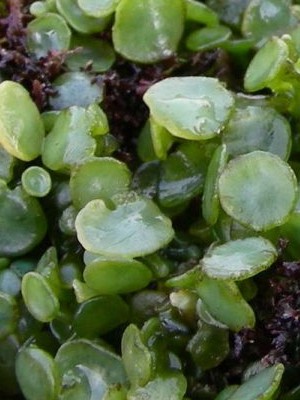
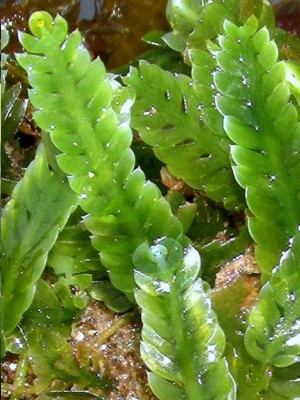
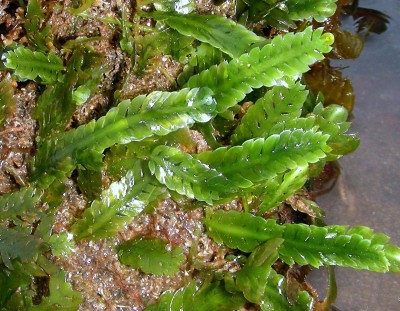
Thanks Vishal,
At least with the photos anyone who wants to consult an expert has something to show them. As Cynthia noted, you seem to have two 'feather-shaped' species of Caulerpa, and the one in your lower photo here, which Cynthia agrees is C. scalpelliformis, is the one the egg mass was on.
The disc-shaped one in your upper photo again illustrates that nudibranchs are not the only group with taxonomic and nomenclatural problems. It could certainly be Caulerpa peltata, which has also been considered a variety of C. racemosa. To illustrate some of the confusion in the literature there is also another similar looking 'species' which in various books is known as both Caulerpa racemosa var exigua and Caulerpa peltata var exigua.
Until names are sorted out, good photos like yours are invaluable records.
Best wishes,
Bill Rudman
Re: Elysia tomentosa from Ratnagiri, India
May 13, 2009
From: Cynthia D. Trowbridge
Concerning message #22438:
Hi Bill,
Actually, Vishal's algal identification is correct. He said that the eggs were on Caulerpa scalpelliformis (bottom right photo). For whole-thallus photos, please look here:http://algaebase.org/search/species/detail/?species_id=1411&sk=0&from=results
The other alga (where the slugs are) could be Caulerpa taxifolia or C. sertularioides (see http://algaebase.org/search/species/detail/?species_id=1412&sk=0&from=results). The two are often confused as they are morphologically similar.
Cordially,
Cynthia
sacoglossans@ymail.com
Trowbridge, C.D., 2009 (May 13) Re: Elysia tomentosa from Ratnagiri, India. [Message in] Sea Slug Forum. Australian Museum, Sydney. Available from http://www.seaslugforum.net/find/22457Thanks Cynthia,
What I was trying to say was that without expert advice, some of these species of Caulerpa are very difficult to identify. What interested me was how this Elysia is often found associated with species of Caulerpa which all have a very similar feather-like shape. Your suggestion that Vishal's animals are associated with two different species of very similar shape illustrates this very well. Of course, as we can see on the Forum, E. tomentosa also appears to be associated with other species of Caulerpa, so maybe the reason it is often found on 'feather-shaped' species of Caulerpa is because such species of Caulerpa often occur in large obvious patches.
Best wishes,
Bill Rudman
Elysia tomentosa from Ratnagiri, India
May 12, 2009
From: Vishal Jayant Bhave
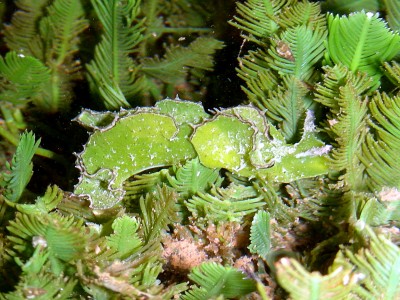
Concerning message #21829:
Dear Bill,
Here is Elysia tomentosa found in an intertidal rockpool with Caulerpa sp.
There were about 25 individuals observed (area approx. 45 x 75 cm) about 3-15 cm from the surface (total depth of rockpool was less than 30 cm)
The images of the animals are from Alawa, Mirya, Ratnagiri captured on 11 December 2008 in the shallow intertidal. They were up to 40 mm long. The photo of the eggs was taken on 24 January 2009 at Mandavi, Ratnagiri, in rockpool; on an alga Caulerpa scalpelliformis.
Locality: Ratnagiri, Maharashtra, India, Arabian sea, Intertidal, rocky shores, Photographer: Vishal Bhave.
Vishal Bhave
vishalbhave@gmail.com
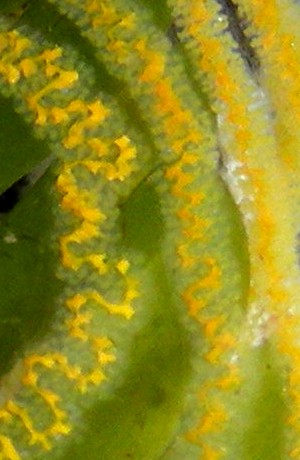
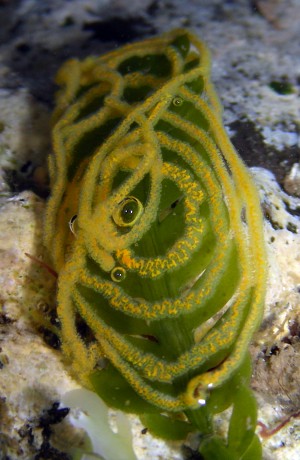
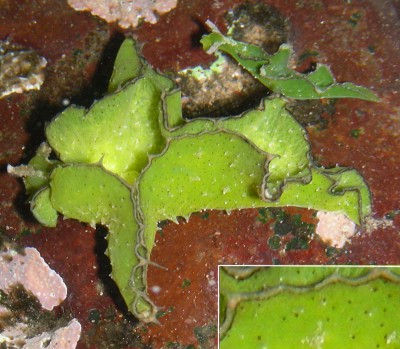
Dear Vishal,
Another interesting find. This is what I have been calling E. tomentosa. It seems to be on the same species of Caulerpathat I have found it on in New Caledonia [message #10486] and Tim Glasby has reported from New South Wales [#10773 ]. Species of Caulerpa are quite difficult to identify 'in the flesh', and extremely difficult to identify from photos but the plant you are calling C. scalpelliformis looks quite similar to the one I am calling C. taxifolia.
Also of interest is your photo of the egg ribbon. In your photo, and others on the same page, the sinuous yellow streak could easily be mistaken for the actual egg string, but as we can see from the close-up, the eggs are colourless and packed together in the egg ribbon while the yellow band is a band of yolk. [see extracapsular yolk Fact Sheet ]
Best wishes,
Bill Rudman
Re: A very hairy Elysia
November 27, 2008
From: Cory Pittman
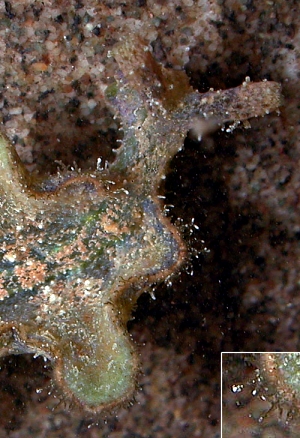
Concerning message #22036:
Dear Bill,
I've spent a lot of time in Hawaii and have kept Elysia tomentosa alive for several weeks on a number of occasions, feeding them on various Caulerpa spp.
On three occasions, I've held relatively "hairy" animals for several weeks with food but under fairly low light. In all three cases, they changed from having long, slender branching papillae with branches of the digestive gland in their centers to having low, conical unbranched papillae that lacked visible branches of the digestive gland. The attached photos illustrate this. The first is of a 14 mm animal taken shortly after capture on June 7, 2005. The second is of the same animal on July 18, 2005. It was fed intermittently with Caulerpa but didn't increase in length over that period. Since the initial and end states roughly cover the range of variation seen in the field in Hawaii, the ability of single individuals to switch between the two (in at least one direction) would probably argue against using the degree of "hairiness" to split the species. Of course, I'm by no means certain that it won't be found to be a complex based on other traits...
Locality: Hekili Point, Maui, 1 m, Hawaii, USA, Pacific, 7 June 2005, back reef. Length: 14 mm. Photographer: Cory Pittman.
By the way, Pauline and I have our site on-line now so, if I may be permitted a bit of "shameless promotion," you can see more photos of Hawaiian E. tomentosa at: http://seaslugsofhawaii.com/species/Elysia-tomentosa-a.html
Also, two other suggestions regarding photos of E. tomentosa on the forum:
To me, it seems likely that Elysia sp. #3 is a juvenile E. tomentosa.
Meanwhile, I think Jun Imamoto's photo (message #10564 ) probably falls outside the "E. tomentosa complex." That species has relatively thick parapodia that form long, narrow lobes with in-rolled margins. It also has relatively thick rhinophores, no marginal lines and evenly scattered, dark green flecks. She has photos of two more animals on her site (in addition to the ones she sent you)--shots 12, 13, 14, 31, 32, 33 & 36 (juv.) at: http://www.umiushi.info/kanri/photo_sql_eng.php?act=PSP&gakumei1=Elysia&gakumei2=cf.+tomentosa&location_code=0000
We also have it from Hawaii: http://seaslugsofhawaii.com/species/Elysia-sp5-a.html
I hope this will be of interest.
Best wishes,
Cory
cory@cet.com
Pittman, C. C., 2008 (Nov 27) Re: A very hairy Elysia. [Message in] Sea Slug Forum. Australian Museum, Sydney. Available from http://www.seaslugforum.net/find/22052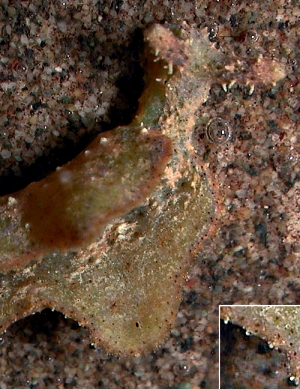
Dear Cory,
This is a very interesting observation. I suspected the branching gill-like papillae were retractile because they seem to be there sometimes and not at other times, but I must admit your onservation that they are apparently reabsorbed, makes using 'hairiness' as a character a rather risky businesss. Obviously the presence of 'hairiness' could still be a useful identifier, but we couldn't use the absence of 'hairiness' to exclude an animal from being E. tomentosa. It would seem that the pink parapodial border may be a useful character. It is certainly present in your animals. One of the reasons I hesitated with Brian Mayes' animals [message #22036] was that they lacked any sign of pink along the parapodial edge.
Concerning Elysia sp. 3. That is another interesting suggestion. Although it a much deeper green than other photos we have, it has a pinkish edge to the parapodia, and the blue spot on its 'neck' links it to some other photos of animals with branched papillae and a pink border to the parapodia such as in Jun Imamoto's message #10567.
Concerning the animal in Jun Imamoto's message #10564, as I commented at the time, I also think it is not the same species as those in the other messages sent at that time.
If all these are indeed one species, it looks as though none of the characters mentioned ['hairiness', blue spot on neck, pink parapodial border] are always present. Interestingly in Jun Imamoto's message #10567 I list these three characters - and a few more - and suggest they could define a species - but may not always be present. This is a bit awkward, but if it does turn out to be so, then this is a very good example of why looking at many specimens can be a very valuable activity. When I get a moment I will have to see just how many of the animals I presently have as Elysia cf tomentosa fit this broader concept of E. tomentosa.
Aside from the identification question, I was excited by your suggestion that the branching papillae contained digestive gland ducts. This suggests that as well as any camouflage function, the papillae are involved with the feeding physiology of the animal and perhaps even the 'farming' of chloroplasts. Your mention of keeping them in low light conditions reminds me of keeping the strange coral-feeding nudibranch Pinufius rebus in the dark [see Fact Sheet] to see what happened to it and its symbiotic zooxanthellae, only to find after a week that all its mantle papillae had been reabsorbed and the zooxanthellae ejected. Perhaps the loss of papillae in your animals was similarly related to unsatisfactory low light conditions for their captive chloroplasts. Certainly an interesting co-incidence which would be worth following up.
Best wishes,
Bill Rudman
Elysia tomentosa from Moreton Bay, Queensland
August 25, 2008
From: Stan O'Donnell
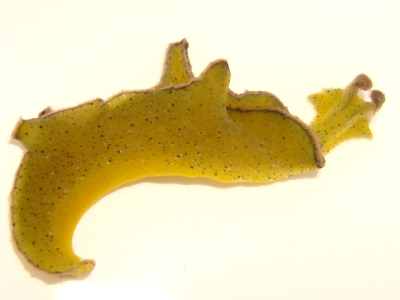
Hello,
Let me just say I love the sea slug forum. I collected this nudibranch a few weeks ago when I was collecting some Caulerpa from Cleveland in SE Queensland Australia. It appears to be some type of Elysia. I have looked through the species list on the forum but could not find any thing that looks the same. I was hoping you might have some ideas as to what this nudibranch could be. I look forward to your reply.
Locality: Cleveland, QLD, Australia, Moreton Bay, intertidal. Photographer: Stan O'Donnell.
Kind Regards
Stan O'Donnell
drmazda@yahoo.com.au
O'Donnell, S., 2008 (Aug 25) Elysia tomentosa from Moreton Bay, Queensland. [Message in] Sea Slug Forum. Australian Museum, Sydney. Available from http://www.seaslugforum.net/find/21829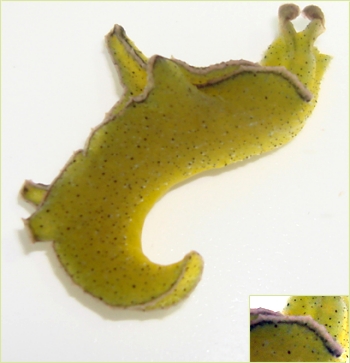
Dear Stan,
It is indeed a species of Elysia, and I am pretty sure it is Elysia tomentosa. As you will see from the Fact Sheet and attached messages, there is still some uncertainty surrounding the identity of this animal but this is the best bet at the moment. The pink parapodial border, outlined in black, seems to be quite characteristic. By the way, although species of Elysia are sea slugs they are not nudibranchs. In some books these two words are considered to mean the same thing, but sea slugs [= opisthobranchs] include not just the nudibranchs, but also the sacoglossans [such as Elysia], the cephalaspideans [bubble shells etc], the anaspideans [sea hares] and a number of other smaller groups.
Best wishes,
Bill Rudman
Elysia tomentosa from Turkey
April 18, 2008
From: Carol Cox
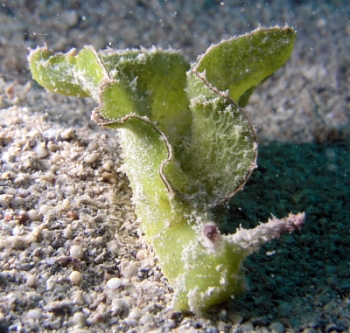
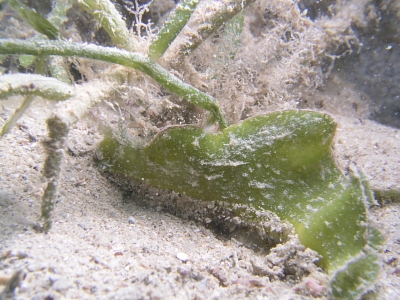
I photographed this possible Elysia at Bogsak Island, east of Mersin, Turkey on 14 Oct 2007. It had a lot of silt on it so it's a little difficult to make out the details.
Locality: Bogsak Island, 45 feet, Mersin, Turkey, Mediterranean, 14 October 2007, Sand and silt, near plant the same color. Length: 1.75 inches. Photographer: Carol Cox.
Carol Cox
ccox@mchsi.com
Cox, C., 2008 (Apr 18) Elysia tomentosa from Turkey. [Message in] Sea Slug Forum. Australian Museum, Sydney. Available from http://www.seaslugforum.net/find/20989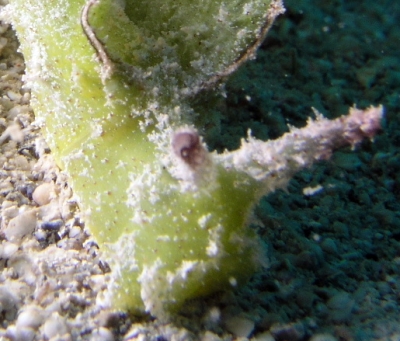
Dear Carol,
This is an animal I am identifying as the Indo-West pacific species Elysia tomentosa. The first records we had from the Mediterranean were from Turkey [see Baki Yokes' message #5649 and later messages]. It certainly seems to have become an established member of the marine fauna - at least in Turkey.
Best wishes,
Bill Rudman
Elysia tomentosa from Japan
November 22, 2005
From: Hironori Ozaki
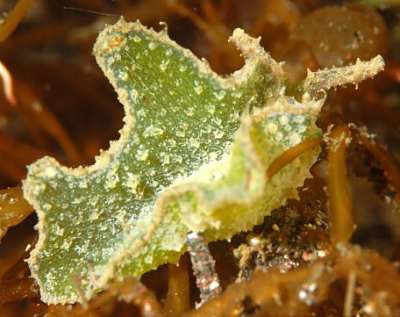
Dear Bill
Here is a photo of Elysia tomentosa from Osezaki, Izu Peninsula, Japan.
Locality: Osezaki, Izu Peninsula, Japan. Depth: 18 m. Length: 2 cm. 30 April 2005. seaweed grows in a sandy area. Photographer: Hironori Ozaki
Hironori Ozaki
h_oza1121@yahoo.co.jp
Hironori Ozaki, 2005 (Nov 22) Elysia tomentosa from Japan. [Message in] Sea Slug Forum. Australian Museum, Sydney. Available from http://www.seaslugforum.net/find/15261Dear Ozaki,
It will be interesting to get some other opinions on the identity of this species. Best wishes,
Bill Rudman
Re: Elysia cf. tomentosa from Turkey
October 15, 2005
From: M. Baki Yokes
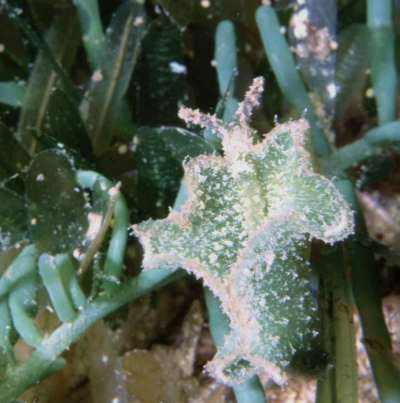
Dear Bill,
Following my earlier message [#10601] and so as not to cause any misunderstanding I have to say that Caulerpa taxifolia (Killer Alga) is not found on the Turkish coastline. The Caulerpa - feeding alien species Elysia tomentosa and Oxynoe viridis feed on either the native Caulerpa prolifera or the alien Caulerpa racemosa. Here we have two varieties of Caulerpa recemosa; C. racemosa var. cylindracea and C. racemosa var. lamourouxii. The C. racemosa var. cylindracea is also considered as an invasive alien species and it is found almost everywhere on the Aegean coatline of Turkey. These two alien seaslugs do not prefer the native Caulerpa prolifera unless there is no C. racemosa in the environment. In contrast, the native seaslug Oxynoe olivacea always prefer Caulerpa prolifera if there is such an option.
Locality: Uc Adalar, Antalya, Turkey. Mediterranean. Depth: 18 m. Length: 8.5 cm. 28 October 2003. On Caulerpa racemosa var. lamourouxii
Photographer: M. Baki Yokes
M. Baki Yokes
bakiyokes@turk.net
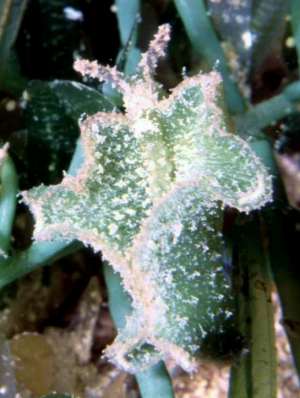
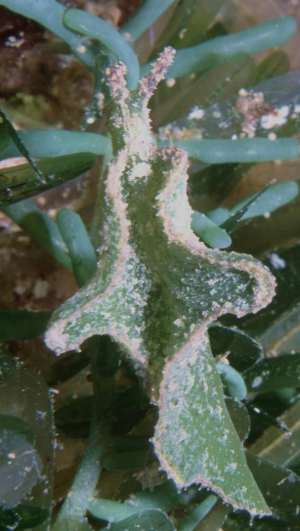
Dear Baki,
Thanks for that. The gradual accumulation of feeding information on all these species is very valuable. It will be interesting to see whether E. tomentosa will eat C. taxifolia when either Caulerpa taxifolia spreads to Turkish waters or Elysia tomentosa moves further west in the Mediterranean to places where C. taxifolia occurs.
Best wishes,
Bill Rudman
Re: Elysia cf. tomentosa from Turkey
October 14, 2005
From: Ferda Buyukbaykal
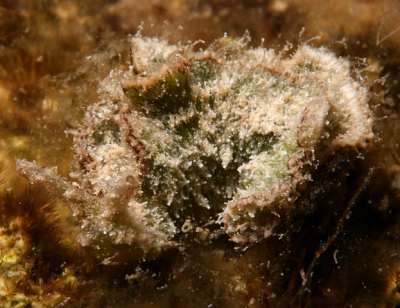
Dear Bill,
Thanks for your comments on my earlier message [#14982]. Here is another photo of it.
Locality: Pirasali island, Adrasan Antalya, Turkey. Depth: 10 m. Length: 8 -10 mm. 09 October 2005. Photographer: Ferda Buyukbaykal
Ferda Buyukbaykal
ferdabbaykal@isnet.net.tr
Buyukbaykal, F., 2005 (Oct 14) Re: Elysia cf. tomentosa from Turkey. [Message in] Sea Slug Forum. Australian Museum, Sydney. Available from http://www.seaslugforum.net/find/14996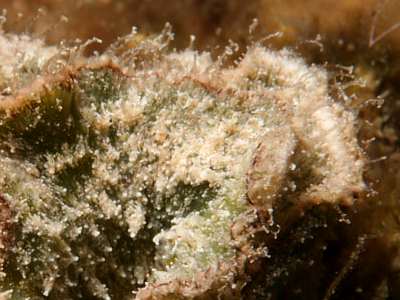
Thanks Ferda,
This shows how well camouflaged these animals can be. In the closeup the pinkish parapodial border and the numerous papillae can be seen clearly. Traces of the thin dark line bordering the brownish pink edge can be seen on the outside of the parapodia, but it seems to be absent on the inside of the parapodia in this specimen.
Best wishes,
Bill Rudman
Elysia cf. tomentosa from Turkey
October 11, 2005
From: Ferda Buyukbaykal
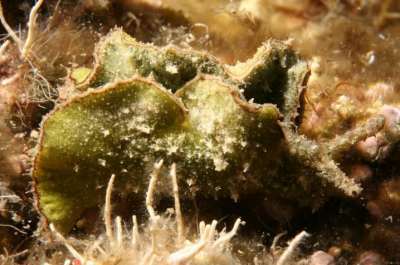
Hi,
Can you help me for identify this nudibranch ?
Is it Elysia grandifolia?
Locality: Pirasali island, Adrasan Antalya, Turkey. Depth: 8-12 m. Length: 10-12 mm. 09 October 2005. Photographer: Ferda Buyukbaykal
Ferda Buyukbaykal
ferdabbaykal@isnet.net.tr
Buyukbaykal, F., 2005 (Oct 11) Elysia cf. tomentosa from Turkey. [Message in] Sea Slug Forum. Australian Museum, Sydney. Available from http://www.seaslugforum.net/find/14982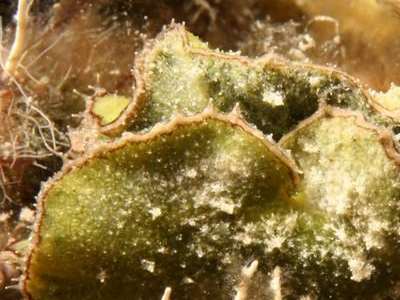
Dear Ferda,
This is what I am calling Elysia tomentosa, but may be different. It has paillae on the parapodia and body, and the parapodia has a pinkish brown line at the margin, edged on both the insise and outside by a thin black line. Have a look at the ongoing discussion on the Forum in messages on the E. tomentosa page. There are some nice photos of it from Turkey where Baki Yokes reports it feeding on Caulerpa taxifolia [message #10601].
Best wishes,
Bill Rudman
Elysia tomentosa from Hawaii
October 4, 2003
From: Keoki Stender
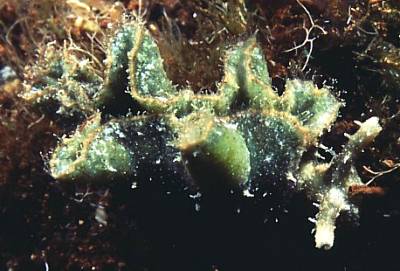
Hi Bill,
Here's what looks like Elysia tomentosa from a tidepool at Kaunolu Bay, SW Lanai, Hawaii. I have never seen this species in Hawaii before. It was on Caulerpa taxifolia, length 25mm, date 15 March 2002.
Thanks,
Keoki Stender
fishpicshi@yahoo.com
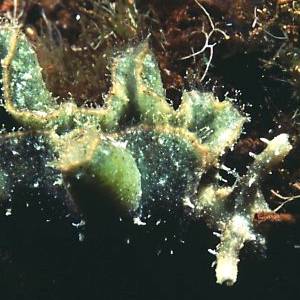
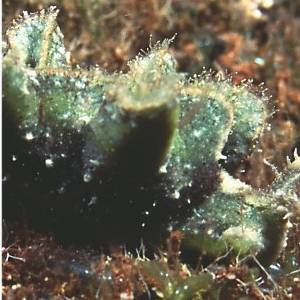
Dear Keoki,
This is an interesting find and certainly looks like E. tomentosa. It is good to have another record of it on Caulerpa taxifolia - the growing records of its association with that species of Caulerpa in widely separated parts of the world suggest that the association is not just an opportunistic relationship.
Best wishes
Bill Rudman
Re: Elysia on Caulerpa taxifolia
August 18, 2003
From: Tim Glasby
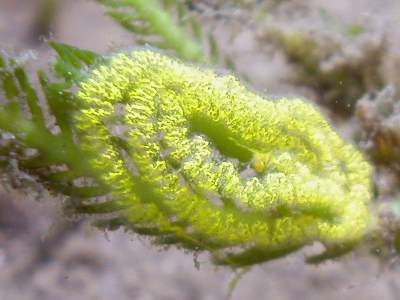
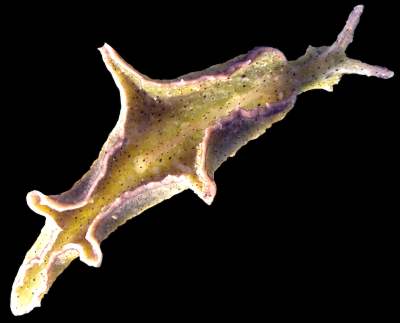
Dear Bill,
Since my first inquiry it has been great to see the recent images of Elysia from all over the world. I have attached a photo of the egg ribbon of the Elysia from Sydney that occurs on Caulerpa taxifolia and a close-up of the mollusc. The eggs look like those photographed by Baki [message 1, message 2]. I will be interested to hear how Baki's research goes. A biological control for C. taxifolia would be wonderful. Unfortunately, there is little indication that E. tomentosa has any signficant effect on the spread of C. taxifolia in Sydney as the alga appears very healthy and covers large areas of seafloor depite having E. tomentosa all over it. Still, there is much we do not know. It does seem, however, that the Elysia have disappeared from many areas in recent weeks, concomitant with a drop in water temperature to around 16 degrees. I have also attached a photo of another nudibranch found on C. taxifolia in Botany Bay (Sydney) at a depth of 3 m. Do you happen to recognise it?
All the best,
Tim Glasby
tim.glasby@fisheries.nsw.gov.au
tim.glasby@fisheries.nsw.gov.au
Glasby, T., 2003 (Aug 18) Re: Elysia on Caulerpa taxifolia. [Message in] Sea Slug Forum. Australian Museum, Sydney. Available from http://www.seaslugforum.net/find/10773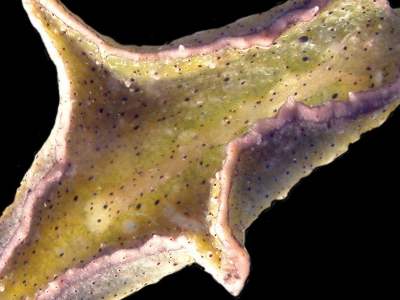
Thanks Tim,
The egg ribbon does look very similar, if not identical, to Baki Yokes's from Turkey, and your photo of the animal clearly shows the marginal pink band and submarginal black lines. Interestingly this specimen is only slightly papillate which suggests the species shows some considerable variation in the degree of papillation. Concerning biological control, I think the general consensus is that we have still to find the sacoglossan that can make any any meaningful impact on a large bed of any species of Caulerpa. Keep us informed of further developments. As you can see, there is a worldwide interest in your animal
Best wishes,
Bill Rudman
Re: Elysia on Caulerpa taxifolia
August 7, 2003
From: Kathe R. Jensen
Dear Bill & Baki,
Thanks for the wonderful pictures of Elysia feeding on Caulerpa prolifera. I think the spacing of the piercings is made by the animal shifting its head from side to side as it moves forwards, so the insertions are made in a zig-zag pattern. I hope that Baki can confirm this by observations in the lab.
I have been hesitant about identifying these animals with E. tomentosa because some years ago I received specimens from India, which showed some minor - but consistent - differences. But in retrospect I think that there may be one very widespread species establishing local "ecotype" populations where food is plentiful. This is one of the cases where molecular studies might help us make a decission.
I am posting a picture of E. tomentosa from the Abrolhos Islands in a separate message.
Best wishes,
Kathe
krjensen@zmuc.ku.dk
Jensen, K.R., 2003 (Aug 7) Re: Elysia on Caulerpa taxifolia. [Message in] Sea Slug Forum. Australian Museum, Sydney. Available from http://www.seaslugforum.net/find/10658Thanks Kathe,
Bill Rudman
Elysia tomentosa from Abrolhos Islands
August 7, 2003
From: Kathe R. Jensen
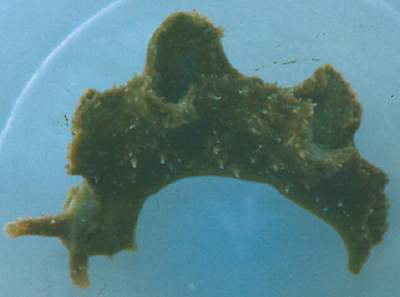
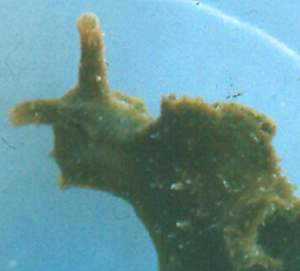
Dear Bill,
I am attaching a picture of Elysia tomentosa from the Abrolhos Islands, Western Australia. The animal was part of the type material for my description of the species. I had a second picture, but something went wrong during the scanning process, so this one will have to do for now.
Greetings,
Kathe
krjensen@zmuc.ku.dk
Jensen, K.R., 2003 (Aug 7) Elysia tomentosa from Abrolhos Islands. [Message in] Sea Slug Forum. Australian Museum, Sydney. Available from http://www.seaslugforum.net/find/10659Thanks Kathe,
It's very valuable to get a photo of the type material of this species. I certainly hope you can send the other one soon. I can see the traces of the pink parapodial border you describe so now we will need to see just how variable this group of Elysia species is. Perhaps as you suggest, there are geographical variants, but at present my photos from New Caledonia look more similar to those from the Mediterranean [which I assume are lessepsian migrants from the Red Sea] than your Indian Ocean animals from Western Australia.
I am posting some photos of similar animals from Japan which may represent one or perhaps two species. I would be grateful for your comments.
Best wishes,
Bill Rudman
Re: Elysia on Caulerpa taxifolia
August 1, 2003
From: Baki Yokes
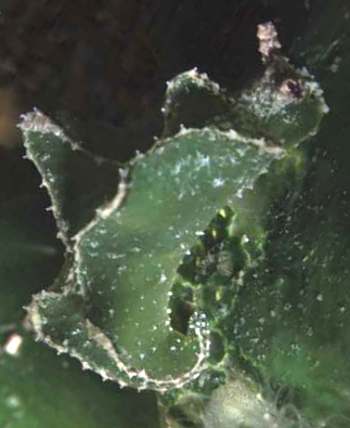
Dear Bill,
It is nice to hear that this species is very much fond of Caulerpa taxifolia, which is known as the Killer Alga in the Mediterranean. The individuals seen in Tim Glasby's message look very much alike the ones in my laboratory, which have been posted in the Forum previously as Elysia cf tomentosa [see first and subsequent messages]. I'm studying their feeding rate on Caulerpa spp. in order to see if they have a potential in controlling the invasion of exotic Caulerpa species in the mediterranean. But besides their feeding habits, we also learned much about their larval development. They lay eggs in a wide range of temperature, 18-29 C. The larva hatches after 10-14 days according to temperature. It is planktotrophic. I could not exactly find out when they settle down, since we have trouble with other zooplankton feeding on the veligers and only a very small percentage of the larva grown to adulthood. But I can say that after they hatch, it takes them nearly one month to attain 1cm in length.
They share one of the tanks with Oxynoe olivacea individuals. Another interesting finding is that both species never eat the Caulerpa leaf if there is an egg ribbon on it. The source of egg ribbon does not matter, both species show respect to each other's. Probably the eggs are protected by similar chemicals. I will inform the Forum after I get a complete result.
Photos: Elysia cf. tomentosa on Caulerpa prolifera leaves - middle row left & right showing leaves after feeding. Lower photo of Elysia veliger. Size: about 200um, 8 days after hatching
Best wishes
Baki
bakiyokes@turk.net
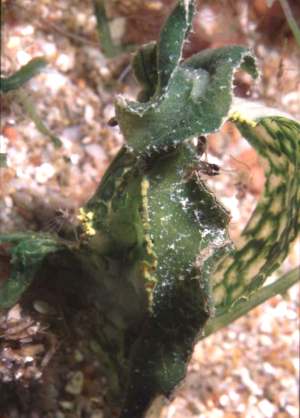
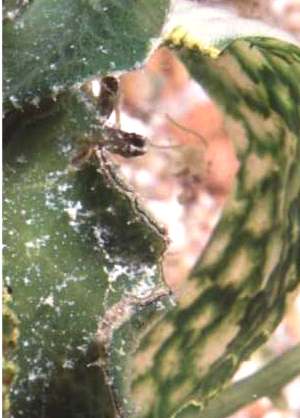
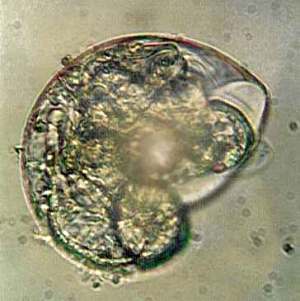
Thanks Baki,
I am pretty sure your animal is the same as the one's I have identified as E. tomentosa. If Kathe Jensen agrees I can move all your earlier mesage to that page. From other messages, which are yet to be posted on the Forum, it appears that there are a number of papillate species we still have to sort out.
Your photos of the 'leaves' of Caulerpa prolifera after Elysia has fed on them are remarkable. I guess the translucent white patches are regions in which the cell contents have been sucked out by the Elysia, the network of green being all that remains of the plant material in the 'leaf'. I guess the centre of each white space is where the cell wall was pierced by the Elysia. It is interesting to see how well spaced these 'piercing points' are. I wonder how such spacing occurs - it can hardly be the result of random acts by the slug.
I look forward to further reports,
Best wishes,
Bill Rudman
Elysia on Caulerpa taxifolia
July 25, 2003
From: Tim Glasby
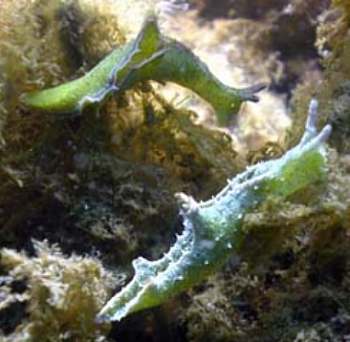
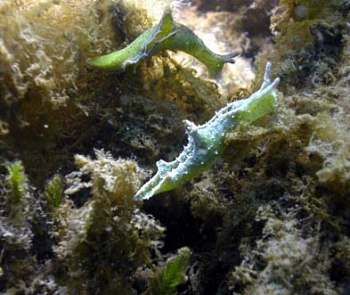
Dear Bill,
Do you happen to recognise this sacoglossan (Elysia sp.?) which is very abundant (~10 per sq metre) on Caulerpa taxifolia in Port Hacking, Sydney. The animals are about 35 mm and the Caulerpa is covered in epiphytes (primarily diatoms I think) at a depth of about 2-5 metres.
Thanks very much,
Tim Glasby
tim.glasby@fisheries.nsw.gov.au
Dear Tim,
As I discuss in a separate message, your photos made me delve a bit deeper into the identity of this species, which I have found before in New Caledonia on Caulerpa taxifolia, or else a Caulerpa which looks very similar. I have also found this species, or something similar, in Queensland and northern New South Wales, so I'll try and see if the photos I have of it are useful. Unfortunately my records associate it with Caulerpa racemosa so it may not be exclusively dependent on Caulerpa taxifolia
My considered opinion is that the best name to give it is Elysia tomentosa. However this posting may lead to further discussion, so I suggest you keep an eye on this page to see if we end up with a better answer.
Concerning the potential of this species in controlling populations of Caulerpa taxifolia it would be interesting to know whether its feeding results in parts of the plant breaking off and regrowing as reported in Lobiger serradifalci [see my comment on Erwin Köhler's message]. It would be interesting to know whether the high abundance you report is common for the species. I certainly have only found it occasionally. If you get a chance of photographing its egg ribbon, that could be useful as it could give us an indication about its type of larval development.
Best wishes,
Bill Rudman
Elysia pilosa & E. tomentosa
July 25, 2003
From: Bill Rudman

Tim Glasby's message of an Elysia on Caulerpa taxifolia has caused me to revisit these papillate elysiids which I have tentatively identified as Elysia pilosa? and Elysia cf tomentosa. It would appear that there is a papillate species, with an elongate renal ridge which has a pinkish border and can also have a black submarginal line visible on both the inside and outside of the parapodia. The only name I can confidently give to this species is Elysia tomentosa Jensen, 1997. Apparently, Jensen, when describing this species, did not have specimens showing the black submarginal line in her collection. I have included close-ups showing this variation in a separate message. It is most probable that Elysia pilosa Risbec, 1927, is an earlier name for this species, but it is not possible to confidently identify the species from his description, especially when we are not sure how many papillate species there are.
PHOTOS: Koumac Beach (=Baie de Ouanap), near Koumac, New Caledonia, 20°34'S, 164°16'E, Mixed soft and hard substrate, grassbeds, algae, 23 October 1993,
Upper Photo: 2 animals, 14, 20mm long alive, AM C200589. Lower Photos: 50mm long alive, on Caulerpa taxifolia. This lower left photo shows the elongate renal ridge behind the pericardium, AM C200588. Photos: Bill Rudman
Bill Rudman

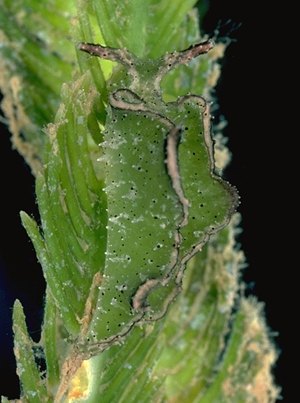
Elysia tomentosa - colour variation
July 25, 2003
From: Bil Rudman
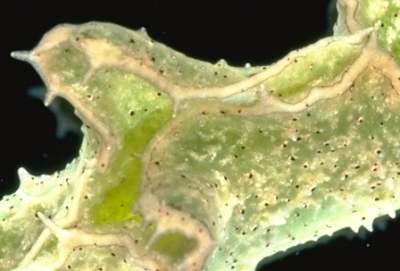
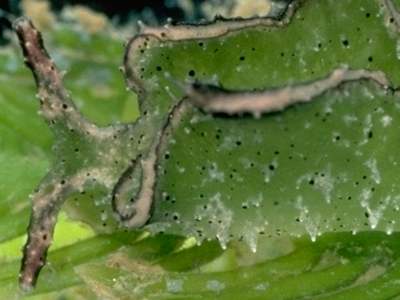
Here are closeups of the two animals from my accompanying message to show the variability in colour more clearly. The upper [and smaller] animal has only a faint hint of the black inner border to the pink parapodial margin, while in the lower [larger] specimen the black line is quite prominent and somewhat diffuse. We can also see in the upper animal that the black spots often have a white ring around them, as described by Jensen in her original description.
PHOTOS: Koumac Beach (=Baie de Ouanap), near Koumac, New Caledonia, 20°34'S, 164°16'E, Mixed soft and hard substrate, grassbeds, algae, 23 October 1993.
Upper Photo: 2 animals, 14, 20mm long alive, AM C200589. Lower Photo: 50mm long alive, on Caulerpa taxifolia, AM C200588. Photos: Bill Rudman
Best wishes,
Bill Rudman
Re: Elysia tomentosa in the Mediterranean?
May 20, 2002
From: Kathe R. Jensen
Dear Baki and Bill,
Thanks for the picture of the egg mass, which certainly also looks very similar to that of E. tomentosa from Western Australia.
It is also nice to know that this species prefers C. racemosa, the "invader" over C. prolifera, the "native" species of Caulerpa. Now we just need to test the feeding preference on C. taxifolia, but I suppose you would have to transport the slugs to Italy or France to do the lab-experiments. Transporting the alga would be illegal - and ecologically dangerous.
Greetings,
Kathe
jensen@ait.ac.th
Jensen, K.R., 2002 (May 20) Re: Elysia tomentosa in the Mediterranean?. [Message in] Sea Slug Forum. Australian Museum, Sydney. Available from http://www.seaslugforum.net/find/7000Elysia tomentosa in the Mediterranean?
May 16, 2002
From: Baki Yokes
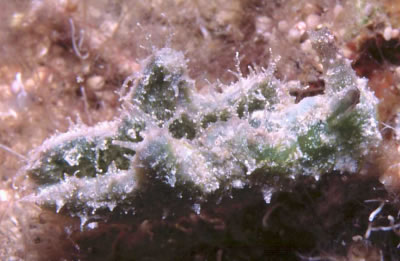
Dear Bill,
Concerning Rob Brown's message, here is some recent information about Elysia cf tomentosa from Turkey. This is the 2nd year that these animals are observed around Uc Adalar, Antalya, Turkey. We kept one of the specimens in an aquarium for a few days to observe its eating habit. Yes, the animal really eats Caulerpa racemosa, and also the local Caulerpa prolifera, but as far as we observe (for a limited amount of time unfortunately) it always prefers C. racemosa if both of them are present in the tank. The specimen was nearly half the size of the previous one that we have posted to the Forum, but it was able to spawn. I found the specimen near its egg mass but I couldn't take its picture. The little guy did us a favor before we let it go back to the sea, and left a beautiful egg mass on the wall of the aquarium.
The water temperature, where we have found the animal and its eggs, was about 18C. I'm not sure whether the animal spawned because of a normal reproduction event or because of stress, but I'm sure that this species is adapted to Mediterranean and within a few years it will become a common species on the C. racemosa fields around Uc Adalar-Antalya. Since we don't have C. taxifolia around Turkish coasts, we couldn't analyse whether this species can be a effective predator for the killer weed or not. We also found a new lessepsian species which I am sending in another message. Their potential to control C. taxifolia invasion should also be examined.
Photographic data:
Animal. Date: 28/04/2002, Antalya, Turkey
Divesite: Kakalak island, Uc Adalar
Depth: 20m, Size: 4.5 cm. Photo: Baki Yokes
Eggs. Date: 1/05/2002, aquarium tank
Size: 1cm in diameter. Photo: Baki Yokes
Best wishes
Baki Yokes
bakiyokes@turk.net
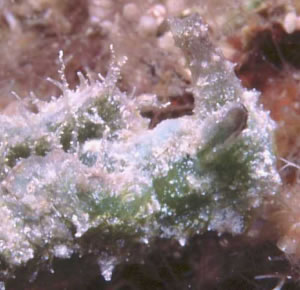
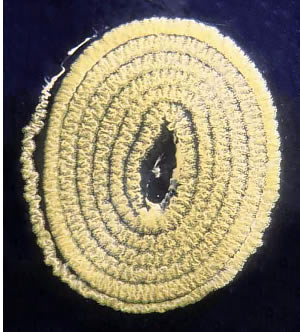
Thanks Baki,
Your animal is almost certainly a visitor from the Indian Ocean but it seems we still have to determine just what is Elysia tomentosa. Two things that will need to be determined is whether the number of folds along the edge of the parapodia are important in determining the species, and whether the white patch on the pericardial hump of some animals is characteristic. It would also be nice to have some photos of the egg ribbon(s) of Indo-West pacific animals to compare with yours.
Best wishes,
Bill Rudman
Elysia tomentosa in the Mediterranean?
May 7, 2002
From: Rob Brown
I'm student at Princeton University writing a paper on the Caulerpa problem, and as I was browsing some of the messages on this site I noticed someone mention the presence of Elysia tomentosa off the shores of Turkey (I believe). Has this been documented, and is Elysia tomentosa significantly better adapted to the cold than Elysia subornata, enabling it to survive the winter? Does the scientific community believe that this might be a legitimate (if accidental) control to the invasive Caulerpas?
Thanks kindly
Rob
robertb@princeton.edu
Brown, R., 2002 (May 7) Elysia tomentosa in the Mediterranean?. [Message in] Sea Slug Forum. Australian Museum, Sydney. Available from http://www.seaslugforum.net/find/6893Dear Rob,
Baki Yokes' message does indicate the presence of Elysia tomentosa or something very similar, in Turkish waters. If you look at subsequent messages on that page you will see Kathe Jensen's comments on the identity of the Turkish animals and also her comments on testing whether it would indeed eat Caulerpa taxifolia.
You ask if the Turkish record has been documented. To my knowledge the message and photos in the Forum are the first record of it from the Mediterranean. If you wish to cite an authority for the record then use the standard citation you will find in small print at the foot of all messages to the Forum. It has become fairly common practice to include reference to messages in the Sea Slug Forum in Literature Cited sections of printed publications.
Best wishes,
Bill Rudman
Re: An alien? from Turkey
January 17, 2002
From: Kathe R. Jensen
Dear Baki,
In answer to your question, Caulerpa racemosa will be an excellent food for Elysia tomentosa. In fact, I think that was the alga I found it on in the Houtman Abrolhos Islands.
Bill, I will keep looking for the slides of this species and see if I can get someone here to scan it.
Greetings,
Kathe
jensen@ait.ac.th
Jensen, K.R., 2002 (Jan 17) Re: An alien? from Turkey. [Message in] Sea Slug Forum. Australian Museum, Sydney. Available from http://www.seaslugforum.net/find/6005Thanks Kathe,
Bill Rudman
Re: An alien? from Turkey
January 16, 2002
From: Baki Yokes
Dear Kathe and Bill,
Thank you very much for the information. I hope to catch more detailed photos of the egg ribbons in the next mating season. About the Caulerpa taxifolia, I have never seen this species although we are searching for it in every dive. But the southwest part of Mediterranean coast of Turkey is densely covered with Caulerpa racemosa, which is another Red Sea immigrant. Can it be a possible food for Elysia tomentosa?
Best wishes
Baki
bakiyokes@turk.net
Yokes, B., 2002 (Jan 16) Re: An alien? from Turkey. [Message in] Sea Slug Forum. Australian Museum, Sydney. Available from http://www.seaslugforum.net/find/5985Re: An alien? from Turkey
January 15, 2002
From: Kathe R. Jensen
Dear Baki and Bill,
I was very excited to see these pictures. It certainly looks like Elysia tomentosa, which would most likely make it a Lessepsian migrant, i.e. a species which migrated through the Suez Canal. Do you have any dense stands of Caulerpa nearby? E. tomentosa feeds exclusively on this algal genus. I know that another alien, Caulerpa taxifolia has been recorded from Turkey, and it would certainly be interesting to see what this Elysia can do to eradicate this alga. So, please keep an eye out for more specimens - and for the settling of larvae.
It is difficult to see the size of individual egg capsules on this photo, but I interpret that as evidence that they are small, and the larvae therefore planktotrophic. In a very similar species, the Caribbean Elysia subornata, the egg capsules are big and the larvae hatch as small crawling juveniles. It has been proposed by a French group of scientists (Prof. A. Meinesz and co-workers) to import this species to the Mediterranean for biological control. Now it seems to be proven that there is a very good possibility that it could migrate to the Red Sea and cause damage to the ecosystem there. Also, E. subornata has now been recorded from the Canary Islands, so it may be a question of time before it also enters the Mediterranean.
It might be interesting to make laboratory experiments on interspecific competition of E. subornata and E. (cf.) tomentosa to see if E. subornata is a superior competitor. Of course, now that E. (cf.) tomentosa is in the Mediterranean, lab. experiments on its feeding on Caulerpa taxifolia should also be made. Maybe - once again - nature has been proved to be more "clever" than people.
Greetings,
Kathe
jensen@ait.ac.th
Jensen, K. R., 2002 (Jan 15) Re: An alien? from Turkey. [Message in] Sea Slug Forum. Australian Museum, Sydney. Available from http://www.seaslugforum.net/find/5976Thanks Kathe,
It is certainly an interesting find. Have you a photo of 'typical' E. tomentosa I could post on the Forum. At present all I have are photos of animals we aren't quite sure about.
Best wishes,
Bill Rudman
An alien? from Turkey
January 14, 2002
From: Baki Yokes

Dear Bill,
Here are some photos of a sea hare-like creature from Turkey. They are always covered with algea which make them very hard to be recognized if they are not looked for. But they have a very bright yellow egg ribbon. In most of the case, it is this egg ribbon which tells that there is one around. They are mostly found in shallow waters between 5-12 meters of depth. Is it an other Red Sea immigrant? Can you name it?
For all photos:
Place: Antalya, Turkey
Divesite: Uc Adalar
Depth: 6m
Size: approx. 8cm, egg ribbon 6cm in diameter
Date: September 2001
Photo: Adnan Buyuk: ado2000tr@yahoo.com
best wishes
Baki
bakiyokes@turk.net
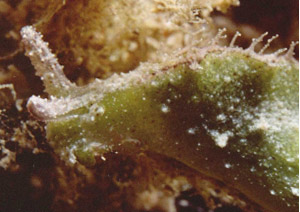
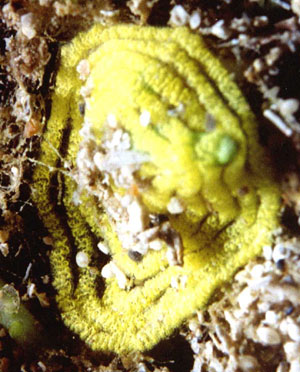
Dear Baki,
This looks like Elysia tomentosa with the very prominent papillae on the inside edge of the parapodia. It will be interesting to see what Kathe Jensen has to say about this one.
Best wishes,
Bill Rudman.
Re: Elysia pilosa?
April 16, 1999
From: Kathe R. Jensen
To Lindsay and others,
There are several species of Elysia in the Indo-West Pacific which all feed on Caulerpa and have an elongate renal ridge.
Elysia expansa has a distinct black line along parapodial edges, tiny black dots on parapodia, small unbranched usually white papillae on whole body, and 2-3 pairs of thickened white glandular spots along parapodial margins.
Elysia tomentosa has a thin reddish or transparent line along parapodial edges; it is densely covered with long papillae, some of which may be branched.
The species identified as Elysia verrucosa in Debelius' book is definitely a misidentification. E. verrucosa from Hong Kong feeds on Cladophorales and has a short pericardium.
Elysia nigropunctata may also belong in the Caulerpa-feeding group, but description is poor. There are probably other, undescribed species in Japan and maybe elsewhere.
Kathe R. Jensen
KRJensen@zmuc.ku.dk
Jensen, K.R., 1999 (Apr 16) Re: Elysia pilosa?. [Message in] Sea Slug Forum. Australian Museum, Sydney. Available from http://www.seaslugforum.net/find/787Thanks Kathe,
Have you got photos of any of these species I could post on the site? What I am still not sure of is whether Lindsay's species is identifiable, and is the species I have photographed at the top of the page E. pilosa?
Best wishes,
Bill Rudman.
Elysia pilosa from Sulawesi
March 24, 1999
From: Lindsay Warren
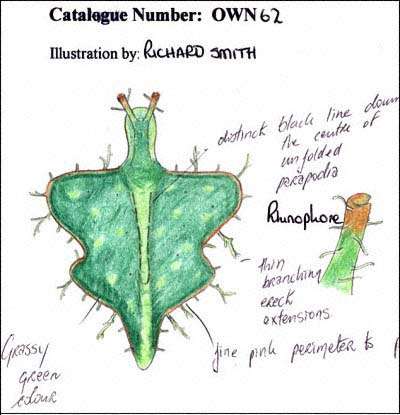
Dear Bill,
Another mystery from Sulawesi [Operation Wallacea]
It is a sketch by Richard Smith. Unfortunately the specimen was lost before it had been photographed. From the details given, I thought it might be Elysia pilosa. What are your thoughts on this?
Length: 1 cm. Colour: uniform grassy green with a fine pink perimeter to the parapodia. Small fine branching extensions were found standing directly up from the body. Down the centre of the body was a distinct black line in a deep U shape as noted in the sketch. The tips of the rhinophores were orange. It was found at a depth of 1 m, on seagrass,
feeding on algae.
Lindsay
100014.2112@compuserve.com
Warren, L., 1999 (Mar 24) Elysia pilosa from Sulawesi. [Message in] Sea Slug Forum. Australian Museum, Sydney. Available from http://www.seaslugforum.net/find/697Note added July 23 2003 - E. pilosa is unidentifiable from original description. I am identifying this as E. tomentosa.
I think your right Lindsay, but as I say at the top of the page I would welcome any comments on whether this species is Elysia pilosa.
Bill Rudman.
?Elysia pilosa
March 19, 1998
From: David & Leanne Atkinson
Bill,
This is the first Elysia that I have seen (Janalie Besoff found it at Fly Point, Port Stephens, NSW in 10M). Elysia expansa and Elysia verrucosa both seem to have black lines down the edge of their "wings", this one doesn't. Any ideas?
Please correct any mis-identifications!
David & Leanne Atkinson
atkin@hunterlink.net.au
Atkinson, D. & L., 1998 (Mar 19) ?Elysia pilosa. [Message in] Sea Slug Forum. Australian Museum, Sydney. Available from http://www.seaslugforum.net/find/58Note added July 23 2003 - E. pilosa is unidentifiable from original description. I am identifying this as E. tomentosa.
Sacoglossans, such as Elysia are often quite common. They are all herbivores and are often well camouflaged, much of their colour being derived from the plants they are feeding on. The leaf-like shape of species of species of Elysia is a clue to the remarkable ability of many of them to keep plant tissue alive in their bodies. Plants have special coloured organelles in their cells called plastids (chloroplasts in green algae) which are able to convert the sun's energy into sugar. This process which is unique to plants, is called photosynthesis. It is vital for all life on earth. Some sacoglossans are able to keep the plastids alive in their own tissues where they provide sugars not for the plants they originated in but for the sea slug.
The taxonomy of many of the species of Elysia is still confused. At present we are still not sure how many species there are and just how much variation in colour can be found in each species. I am not sure whether the slug illustrated as Elysia expansa in Wells & Bryce, 1993: 64, Fig. 68 is correctly identified and I am not sure whether the black line around the edge of the parapodia is an important character. At present I am using a name given by Risbec for a species he found in New Caledonia, but I could be wrong. Any comments from an expert?.. Bill Rudman
Rudman, W.B., 1998 (Mar 19). Comment on ?Elysia pilosa by David & Leanne Atkinson. [Message in] Sea Slug Forum. Australian Museum, Sydney. Available from http://www.seaslugforum.net/find/58